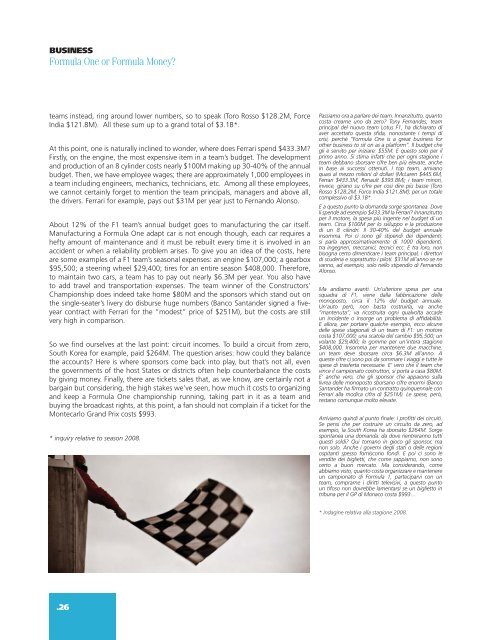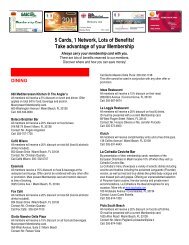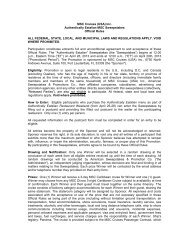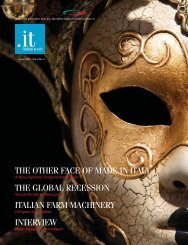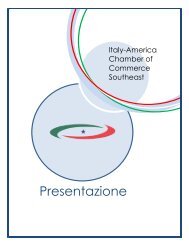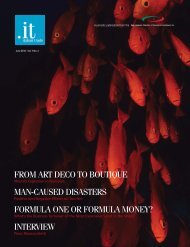interview - Italy-America Chamber of Commerce, Southeast
interview - Italy-America Chamber of Commerce, Southeast
interview - Italy-America Chamber of Commerce, Southeast
Create successful ePaper yourself
Turn your PDF publications into a flip-book with our unique Google optimized e-Paper software.
BUSINESS<br />
Formula One or Formula Money?<br />
teams instead, ring around lower numbers, so to speak (Toro Rosso $128.2M, Force<br />
India $121.8M). All these sum up to a grand total <strong>of</strong> $3.1B*.<br />
At this point, one is naturally inclined to wonder, where does Ferrari spend $433.3M?<br />
Firstly, on the engine, the most expensive item in a team’s budget. The development<br />
and production <strong>of</strong> an 8 cylinder costs nearly $100M making up 30-40% <strong>of</strong> the annual<br />
budget. Then, we have employee wages; there are approximately 1,000 employees in<br />
a team including engineers, mechanics, technicians, etc. Among all these employees,<br />
we cannot certainly forget to mention the team principals, managers and above all,<br />
the drivers. Ferrari for example, pays out $31M per year just to Fernando Alonso.<br />
About 12% <strong>of</strong> the F1 team’s annual budget goes to manufacturing the car itself.<br />
Manufacturing a Formula One adapt car is not enough though, each car requires a<br />
hefty amount <strong>of</strong> maintenance and it must be rebuilt every time it is involved in an<br />
accident or when a reliability problem arises. To give you an idea <strong>of</strong> the costs, here<br />
are some examples <strong>of</strong> a F1 team’s seasonal expenses: an engine $107,000; a gearbox<br />
$95,500; a steering wheel $29,400; tires for an entire season $408,000. Therefore,<br />
to maintain two cars, a team has to pay out nearly $6.3M per year. You also have<br />
to add travel and transportation expenses. The team winner <strong>of</strong> the Constructors’<br />
Championship does indeed take home $80M and the sponsors which stand out on<br />
the single-seater’s livery do disburse huge numbers (Banco Santander signed a fiveyear<br />
contract with Ferrari for the “modest” price <strong>of</strong> $251M), but the costs are still<br />
very high in comparison.<br />
So we find ourselves at the last point: circuit incomes. To build a circuit from zero,<br />
South Korea for example, paid $264M. The question arises: how could they balance<br />
the accounts? Here is where sponsors come back into play, but that’s not all, even<br />
the governments <strong>of</strong> the host States or districts <strong>of</strong>ten help counterbalance the costs<br />
by giving money. Finally, there are tickets sales that, as we know, are certainly not a<br />
bargain but considering, the high stakes we’ve seen, how much it costs to organizing<br />
and keep a Formula One championship running, taking part in it as a team and<br />
buying the broadcast rights, at this point, a fan should not complain if a ticket for the<br />
Montecarlo Grand Prix costs $993.<br />
* inquiry relative to season 2008.<br />
Passiamo ora a parlare dei team. Innanzitutto, quanto<br />
costa crearne uno da zero? Tony Fernandes, team<br />
principal del nuovo team Lotus F1, ha dichiarato di<br />
aver accettato questa sfida, nonostante i tempi di<br />
crisi, perché “Formula One is a great business for<br />
other business to sit on as a platform”. Il budget che<br />
gli è servito per iniziare: $55M. E questo solo per il<br />
primo anno. Si stima infatti che per ogni stagione i<br />
team debbano sborsare cifre ben più elevate, anche<br />
in base ai successi ottenuti. I top team, arrivano<br />
quasi al mezzo milioni di dollari (McLaren $445.6M,<br />
Ferrari $433.3M, Renault $393.8M); i team minori,<br />
invece, girano su cifre per così dire più basse (Toro<br />
Rosso $128.2M, Force India $121.8M); per un totale<br />
complessivo di $3.1B*.<br />
E a questo punto la domanda sorge spontanea. Dove<br />
li spende ad esempio $433.3M la Ferrari? Innanzitutto<br />
per il motore, la spesa più ingente nel budget di un<br />
team. Circa $100M per lo sviluppo e la produzione<br />
di un 8 cilindri. Il 30-40% del budget annuale<br />
insomma. Poi ci sono gli stipendi dei dipendenti;<br />
si parla approssimativamente di 1000 dipendenti,<br />
tra ingegneri, meccanici, tecnici ecc. E tra loro, non<br />
bisogna certo dimenticare i team principal, i direttori<br />
di scuderia e soprattutto i piloti. $31M all’anno se ne<br />
vanno, ad esempio, solo nello stipendio di Fernando<br />
Alonso.<br />
Ma andiamo avanti. Un’ulteriore spesa per una<br />
squadra di F1, viene dalla fabbricazione delle<br />
monoposto, circa il 12% del budget annuale.<br />
Un’auto però, non basta costruirla, va anche<br />
“mantenuta”; va ricostruita ogni qualvolta accade<br />
un incidente o insorge un problema di affidabilità.<br />
E allora, per portare qualche esempio, ecco alcune<br />
delle spese stagionali di un team di F1: un motore<br />
costa $107,000; una scatola del cambio $95,500; un<br />
volante $29,400; le gomme per un’intera stagione<br />
$408,000. Insomma per mantenere due macchine,<br />
un team deve sborsare circa $6.3M all’anno. A<br />
queste cifre ci sono poi da sommare i viaggi e tutte le<br />
spese di trasferta necessarie. E’ vero che il team che<br />
vince il campionato costruttori, si porta a casa $80M.<br />
E’ anche vero, che gli sponsor che appaiono sulla<br />
livrea delle monoposto sborsano cifre enormi (Banco<br />
Santander ha firmato un contratto quinquennale con<br />
Ferrari alla modica cifra di $251M). Le spese, però,<br />
restano comunque molto elevate.<br />
Arriviamo quindi al punto finale: i pr<strong>of</strong>itti dei circuiti.<br />
Se pensi che per costruire un circuito da zero, ad<br />
esempio, la South Korea ha sborsato $264M. Sorge<br />
spontanea una domanda: da dove rientreranno tutti<br />
questi soldi? Qui tornano in gioco gli sponsor, ma<br />
non solo. Anche i governi degli stati o delle regioni<br />
ospitanti spesso forniscono fondi. E poi ci sono le<br />
vendite dei biglietti, che come sappiamo, non sono<br />
certo a buon mercato. Ma considerando, come<br />
abbiamo visto, quanto costa organizzare e mantenere<br />
un campionato di Formula 1, parteciparvi con un<br />
team, comprarne i diritti televisivi, a questo punto<br />
un tifoso non dovrebbe lamentarsi se un biglietto in<br />
tribuna per il GP di Monaco costa $993…<br />
* indagine relativa alla stagione 2008.<br />
.26


